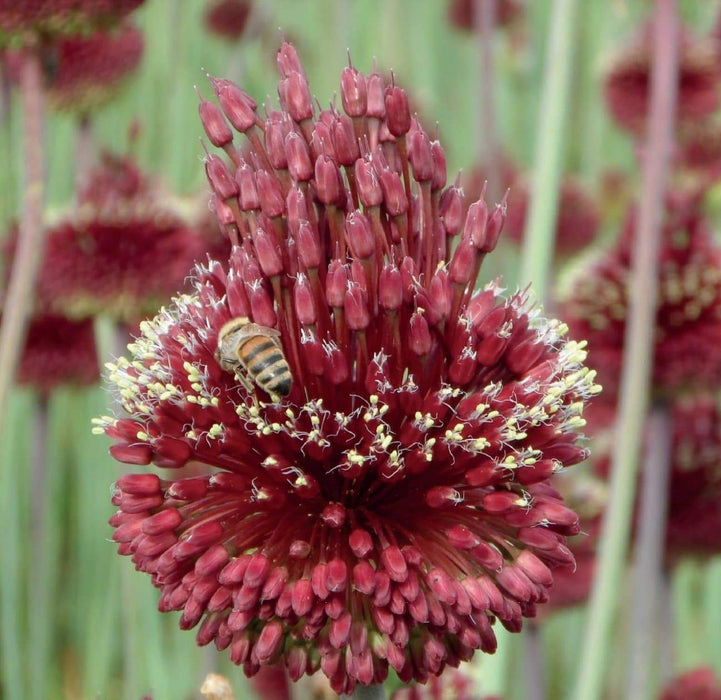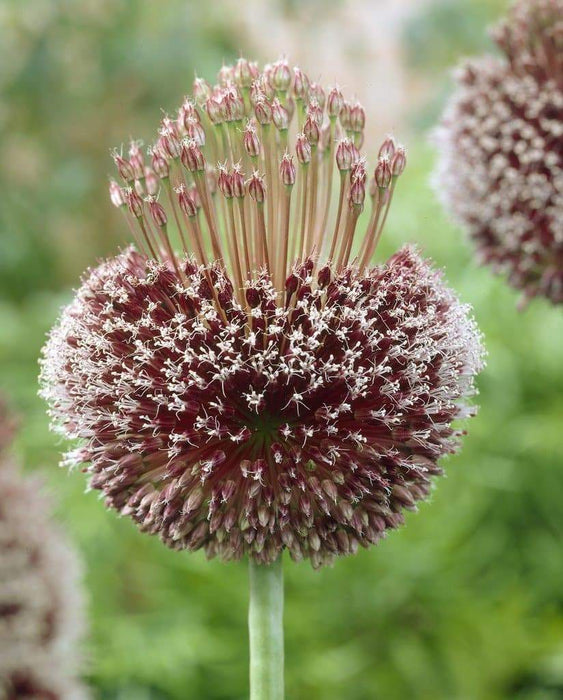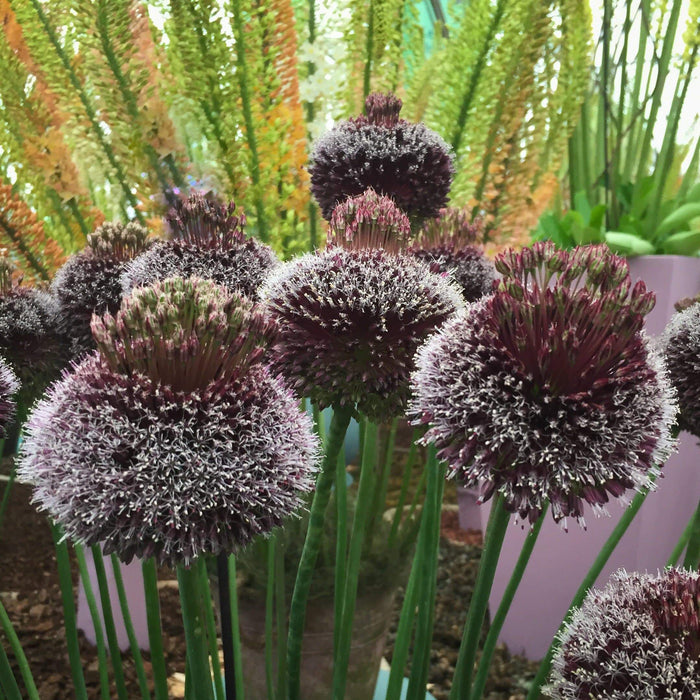
Allium Forelock - Bulbs, 20/+ cm !
Most orders are processed by the next day
Select your desired size and/or color from the available options.
Allium Forelock will really bring a spectacle to your garden! A unique and pleasantly perfumed ornamental onion. As the flowering progresses, a tuft of flowers protrudes a few inches above the egg-shaped burgundy red flower, which has the effect of a lock of hair. The protruding white stamens start to stand out more and more during the flowering period, creating a white haze over the burgundy red flower. Allium Forelock starts blooming in June. This unique Allium is a great addition to our Allium range and a must have for the adventurous gardener.
You might know the allium family from the chives in your herb garden: little fluffy purple balls much beloved by bees and butterflies. But ornamental alliums are anything but little. These gigantic globes on tall stems are all about bringing big drama to your garden. If you grow bulbs with children, be sure to include some alliums, as children love the fact that once in bloom these flowers will often tower over them.
Height: 24 Inches.
Bulb size: 12/+ cm.
• Deer Resistant
• Attracts Bees and Butterflies
• Fragrant
• Easy To Grow
How to grow Allium bulbs?
Like all flower bulbs, alliums need a cold period to develop their roots and get ready for spring. So once you feel fall’s first chill in the air, it’s time to get planting.
Flower bulbs are tough cookies that are easy to grow, but one thing they hate is getting their feet wet: a bulb that is ‘bathing’ in water will rot in no time. So avoid soggy soil at all cost – this means places where you can still see puddles 5-6 hours after a rainstorm. Another thing you can do is to upgrade potentially soggy soil by adding organic material such as peat, bark or manure. When it comes to planting bulbs in containers, the mantra is exactly the same: drainage-drainage-drainage. Get a pot or box with at least some drainage holes at the bottom.
Alliums need plenty of light to grow, so any place with less than full sun is out.
Alliums will need to be planted deep enough that they won’t be affected by temperature variations above ground, either too warm or too cold. Unfortunately containers can’t protect bulbs as well as mother earth can, so when you live in hardiness zones 3-7 it might be better to let your containers spend the winter indoors, in a cool, dark, well-aired spot that won’t get warmer than 60 degrees Fahrenheit, like an unheated basement or garage.
The standard method for calculating the ideal depth is to dig a hole three times as deep as the bulb is high, and place the bulb at the bottom with its pointy end up. Since alliums grow less well when they have to fight for nutrients with their fellow bulbs, it’s best to plant them 6-8” apart.
To help the bulbs settle and grow roots quickly, it’s important to water them well after planting, but after that you won’t have to water them again. Now all you have to do is wait patiently for winter to do its magic underground, and spring to surprise you with the rewards of your work.
During blooming season, you generally don’t have to water your alliums, but you can water them when there hasn’t been any rain for 3-5 days.
After alliums have finished blooming, don’t cut the foliage straight away: through photosynthesis the leaves will create nutrients that the bulb will be needing for its next growing season. After a few weeks the foliage will automatically yellow and die back, and then you can remove it. Now the bulb will be going dormant, and won’t need any watering until next spring.
HOW TO PLANT ALLIUMS IN YOUR GARDEN:
- Wait until the soil is 60 degrees Fahrenheit or colder. In the North this will be in September or October, in the South in October or November.
- Pick a spot in your garden that has well-draining soil and gets full sun.
- Plant the allium bulbs about 4-8” deep and 6-8” apart, placing them in the ground with their pointy ends up.
- Water well once and wait for spring
- After the alliums have bloomed don’t cut off the foliage. Leave it until it’s completely withered and yellow, then remove.
- Wait until it’s cold outside, with a soil temperature of 60 degrees Fahrenheit or lower. In the North this will be in September or October, in the South in October or November.
- Pick a spot in your garden that gets full sun.
- Find a well-draining container and fill it with loose soil, making sure water won’t gather and stay at the bottom.
- Plant the allium bulbs about 4-8” deep and 6-8” apart, placing them in the soil with their pointy ends up. Since containers often have limited space, you can also experiment with placing the bulbs closer together, but make sure they never touch.
- Water well once and wait for spring, or, when you live in hardiness zone 3-7, water well and bring the containers indoors, letting them spend the winter in a cool spot like an unheated garage or basement.
- After the alliums have bloomed don’t cut off the foliage. Leave it until it’s completely withered and yellow, then remove.
LET OUR CUSTOMER SPEAK FOR US

![[Seeds] - Caribbeangardenseed](http://caribbeangardenseed.com/cdn/shop/files/gift-card-gift-card-1_1024x1024_dfa857db-9150-4315-a362-7f0bb3fb9c47_60x28.png?v=1703978838)


